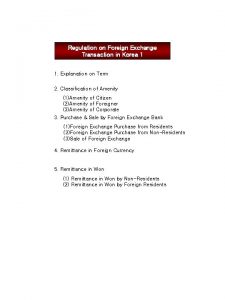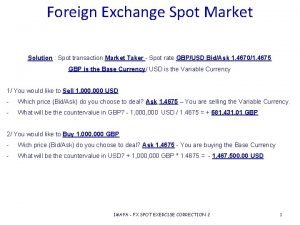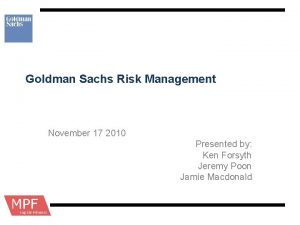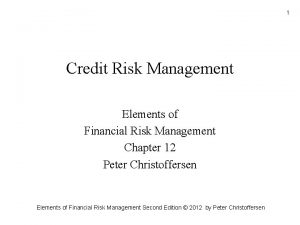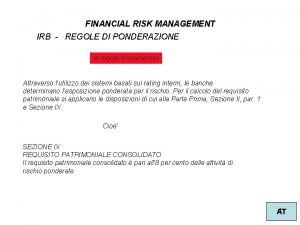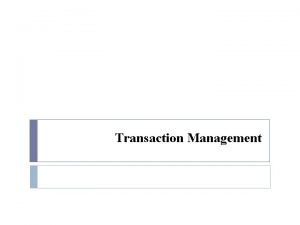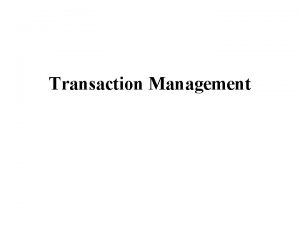Credit risk management Foreign Trade Transaction Lecture 11










- Slides: 10

Credit risk management Foreign Trade Transaction Lecture 11 th Dr. Katalin Csekő

Definitions Risk management deals with: evaluating and minimizing the risks of non payment, or partial payment faced by a seller/creditor; The credit risk can be accompanied with: ü Loss of possession of the goods; ü Reduction (or loss) of income due to fluctuation of exchange rate of the agreed currency; ü Costs of litigation procedure in order to enforce the payment; ü Liquidity problems; ü The injury of intellectual property rights;

Types of risk management The risks are inherent; The obligation to mitigate the losses is a fundamental of international trade law; Approaches to handle the risks: ü To refuse risks=risk avoidance; ü To accept risks=loss prevention; loss reduction; How to handle/cover risks? By self insurance: a company is accumulating funds for any losses; By allocation of the risks: securities; By legal measures: retention of title, compensation provision; By insurance cover;

Security tools Proprietary right in assets; Proprietary rights in tangible or intangible assets: Personal securities; Personal securities can be divided: ü Dependent= surety-hip or (bank)guaranty; ü Independent= (bank)guarantee The value of the personal security= value of the security provider; The actors: Debtor, creditor and security provider nominated and appointed by the debtor;

(Bank)-Guarantee Independent personal security; Irrevocable payment obligation of the security provider= guarantor, on first demand; In Europe only bank are authorized to issue; In USA and other countries: corporates, and rich families as well; It is a default instrument= a bank promises payment if his principal does not fulfill its obligation. This obligation can be of different nature (above all payment obligation); Beneficiary: The party (seller) , to whose benefit the bank guarantees the payment in the event of non-performance by his principal. Principal: The debtor of the original obligation, and the bank’s customer that appoints the issue of the guarantee;

The bank-guarantee A bank guarantee should be: irrevocable, unconditional, divisible; Irrevocable=the Guarantee can not be modified or cancelled without the permission of the beneficiary; Unconditional= the bank pays irrespective of the underlying transaction only upon the first demand or some documents of the beneficiary; within the validity of the bank guarantee; after the expiry date the guarantor has no more obligation; To call upon the guarantor to pay, the beneficiary has to present (through bank channel): documents indicated in the letter/contract of bank guarantee. There is only one exception: evident fraud;

Types of bank-guarantee Beneficiary is the seller: ü Payment guarantee; Beneficiary is the buyer: ü Good-performance guarantee: for the risk that exporter/contractor will fail to perform adequately. The guarantee amount is up to 10% of the contract price; It is to be opened as contracting provision; ü Warranty guarantee; ü Tender guarantee; It is 5 -10% of the proposed contractual price; it should be provided as a part of the proposal; ü Advance payment guarantee; for the case if the seller had down payment from the buyer;

Issuance of the guarantee (payment guarantee) Importer/debtor Principal 1. Exporter/creditor ↔ beneficiary underlying transaction 2. 4. Notice of the guarantee Guarantee application + deposit Bank, guarantor guarantee contract 3. Advising/Confirming Bank

Call/ demand of the guarantee (payment guarantee) Demanding the guarantor to pay, the beneficiary has usually to present through its bank channel the following documents: ü Its demand supported by: ü a statement that the beneficiary delivered the goods and has never received the counter value; ü commercial invoice on goods delivered, not paid, ü copy of the transport document;

Dependent personal security Its roots trace back to the Roman Empire=Guaranty; The guarantor undertakes the payment if the original debtor did not/would not pay, BUT The guarantor steps into the position (shoes) of the original debtor and MUST invoke all objections to the contract/underlying transaction (denying the legal ground of payment such as defective goods etc. ) which the original debtor could have invoked! ↔ The independent security! The bank-guarantor has to be jointly and severally liable towards the beneficiary= has to pay irrespective of the fact whether or not the original debtor can be liquidated IF there is no failure on the side of the original creditor )e. g. seller) ↔ The independent security!
 Market risk assessment
Market risk assessment Credit risk in international trade
Credit risk in international trade So here you are too foreign for home
So here you are too foreign for home Foreign exchange transaction regulation korea
Foreign exchange transaction regulation korea Spot market exchange
Spot market exchange Risk management lecture
Risk management lecture Credit union enterprise risk management
Credit union enterprise risk management Credit risk management and advisory goldman sachs
Credit risk management and advisory goldman sachs Step1credit
Step1credit Elements of credit risk management
Elements of credit risk management Metodo irb
Metodo irb



